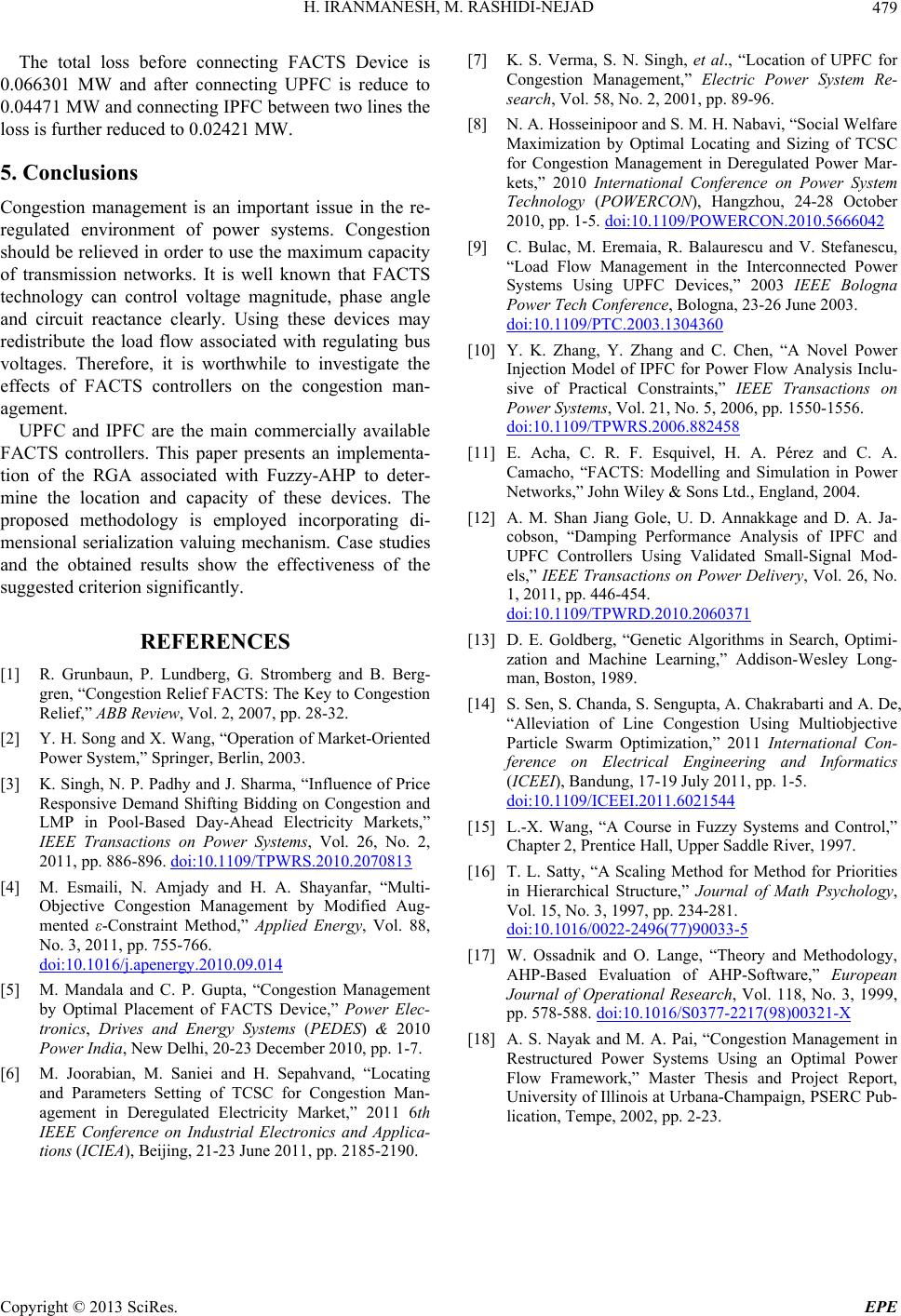
H. IRANMANESH, M. RASHIDI-NEJAD
Copyright © 2013 SciRes. EPE
479
re connecting FACTS Dev
0.
ment is an important issue in the re-
FC are the main commercially available
FA
[1] R. Grunbaun,berg and B. Berg-
t-Oriented
nfluence of Price
The total loss befoice is
066301 MW and after connecting UPFC is reduce to
0.04471 MW and connecting IPFC between two lines the
loss is further reduced to 0.02421 MW.
5. Conclusions
Congestion manage
regulated environment of power systems. Congestion
should be relieved in order to use the maximum capacity
of transmission networks. It is well known that FACTS
technology can control voltage magnitude, phase angle
and circuit reactance clearly. Using these devices may
redistribute the load flow associated with regulating bus
voltages. Therefore, it is worthwhile to investigate the
effects of FACTS controllers on the congestion man-
agement.
UPFC and IP
CTS controllers. This paper presents an implementa-
tion of the RGA associated with Fuzzy-AHP to deter-
mine the location and capacity of these devices. The
proposed methodology is employed incorporating di-
mensional serialization valuing mechanism. Case studies
and the obtained results show the effectiveness of the
suggested criterion significantly.
REFERENCES
P. Lundberg, G. Strom
gren, “Congestion Relief FACTS: The Key to Congestion
Relief,” ABB Review, Vol. 2, 2007, pp. 28-32.
[2] Y. H. Song and X. Wang, “Operation of Marke
Power System,” Springer, Berlin, 2003.
[3] K. Singh, N. P. Padhy and J. Sharma, “I
Responsive Demand Shifting Bidding on Congestion and
LMP in Pool-Based Day-Ahead Electricity Markets,”
IEEE Transactions on Power Systems, Vol. 26, No. 2,
2011, pp. 886-896. doi:10.1109/TPWRS.2010.2070813
[4] M. Esmaili, N. Amjady and H. A. Shayanfar, “Multi-
Objective Congestion Management by Modified Aug-
mented ε-Constraint Method,” Applied Energy, Vol. 88,
No. 3, 2011, pp. 755-766.
doi:10.1016/j.apenergy.2010.09.014
estion Management [5] M. Mandala and C. P. Gupta, “Cong
by Optimal Placement of FACTS Device,” Power Elec-
tronics, Drives and Energy Systems (PEDES) & 2010
Power India, New Delhi, 20-23 December 2010, pp. 1-7.
[6] M. Joorabian, M. Saniei and H. Sepahvand, “Locating
and Parameters Setting of TCSC for Congestion Man-
agement in Deregulated Electricity Market,” 2011 6th
IEEE Conference on Industrial Electronics and Applica-
tions (ICIEA), Beijing, 21-23 June 2011, pp. 2185-2190.
[7] K. S. Verma, S. N. Singh, et al., “Location of UPFC for
Congestion Management,” Electric Power System Re-
search, Vol. 58, No. 2, 2001, pp. 89-96.
[8] N. A. Hosseinipoor and S. M. H. Nabavi, “Social Welfare
Maximization by Optimal Locating and Sizing of TCSC
for Congestion Management in Deregulated Power Mar-
kets,” 2010 International Conference on Power System
Technology (POWERCON), Hangzhou, 24-28 October
2010, pp. 1-5. doi:10.1109/POWERCON.2010.5666042
[9] C. Bulac, M. Eremaia, R. Balaurescu and V. Stefanescu,
“Load Flow Management in the Interconnected Power
Systems Using UPFC Devices,” 2003 IEEE Bologna
Power Tech Conference, Bologna, 23-26 June 2003.
doi:10.1109/PTC.2003.1304360
[10] Y. K. Zhang, Y. Zhang and C. Chen, “A Novel Power
Injection Model of IPFC for Power Flow Analysis Inclu-
sive of Practical Constraints,” IEEE Transactions on
Power Systems, Vol. 21, No. 5, 2006, pp. 1550-1556.
doi:10.1109/TPWRS.2006.882458
[11] E. Acha, C. R. F. Esquivel, H. A. Pérez and C. A.
Camacho, “FACTS: Modelling and Simulation in Power
Networks,” John Wiley & Sons Ltd., England, 2004.
[12] A. M. Shan Jiang Gole, U. D. Annakkage and D. A. Ja-
cobson, “Damping Performance Analysis of IPFC and
UPFC Controllers Using Validated Small-Signal Mod-
els,” IEEE Transactions on Power Delivery, Vol. 26, No.
1, 2011, pp. 446-454.
doi:10.1109/TPWRD.2010.2060371
[13] D. E. Goldberg, “Genetic Algorithms in Search, Optimi-
zation and Machine Learning,” Addison-Wesley Long-
man, Boston, 1989.
[14] S. Sen, S. Chanda, S. Sengupta, A. Chakrabarti and A. De,
“Alleviation of Line Congestion Using Multiobjective
Particle Swarm Optimization,” 2011 International Con-
ference on Electrical Engineering and Informatics
(ICEEI), Bandung, 17-19 July 2011, pp. 1-5.
doi:10.1109/ICEEI.2011.6021544
[15] L.-X. Wang, “A Course in Fuzzy Systems and Control,”
Chapter 2, Prentice Hall, Upper Saddle River, 1997.
[16] T. L. Satty, “A Scaling Method for Method for Priorities
in Hierarchical Structure,” Journal of Math Psychology,
Vol. 15, No. 3, 1997, pp. 234-281.
doi:10.1016/0022-2496(77)90033-5
[17] W. Ossadnik and O. Lange, “Theory and Methodology,
AHP-Based Evaluation of AHP-Software,” European
Journal of Operational Research, Vol. 118, No. 3, 1999,
pp. 578-588. doi:10.1016/S0377-2217(98)00321-X
[18] A. S. Nayak and M. A. Pai, “Congestion Management in
Restructured Power Systems Using an Optimal Power
Flow Framework,” Master Thesis and Project Report,
University of Illinois at Urbana-Champaign, PSERC Pub-
lication, Tempe, 2002, pp. 2-23.